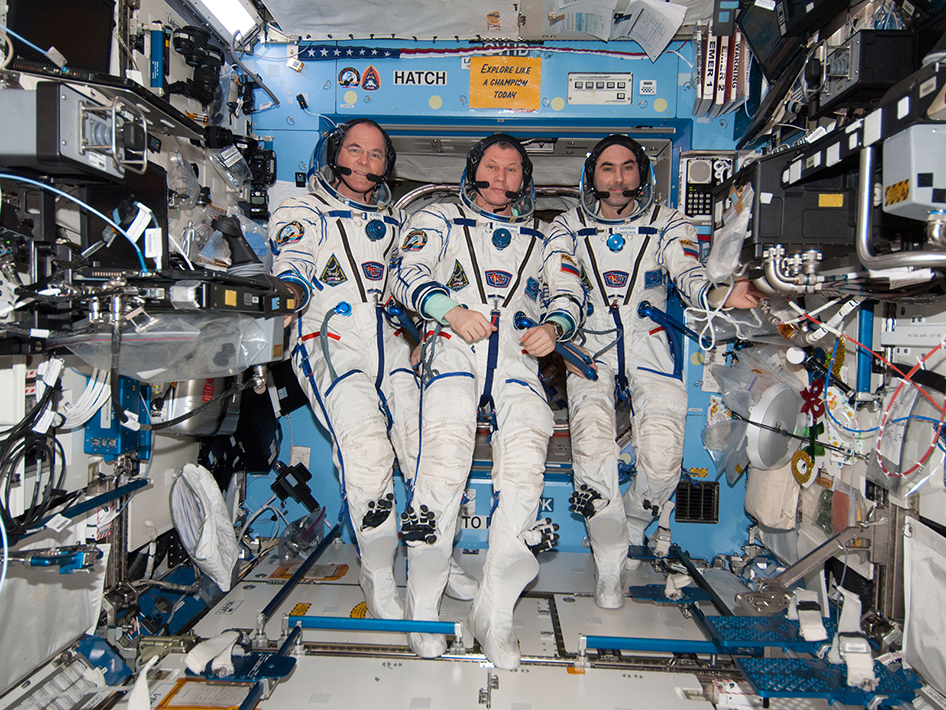Space Station Crew's Landing Delayed by 'Horrible' Earth Weather

An American astronaut and two Russian cosmonauts are stuck in space for one more day after freezing rain and fog on Earth prevented them from landing in Central Asia on Thursday (March 14), NASA officials say.
The foul weather, which one Russian space agency official described simply as "horrible," means NASA astronaut Kevin Ford and cosmonauts Oleg Novitskiy and Evgeny Tarelkin had to delay their return from the International Space Station for at least 24 hours. The three men have been living in space for 141 days and were preparing to enter their Soyuz spacecraft for a landing on the frigid steppes of Kazakhstan tonight.
"We are waving off landing," NASA spokesperson Rob Navias said during live mission commentary. "No Soyuz landing tonight."
The rain and fog in Kazakhstan is not a threat to the Soyuz spacecraft and crew, Navias said. But the recovery helicopters essential for retrieving the astronauts after landing would not be able to make it to their staging grounds for the landing because of bad weather conditions. [See photos of the Expedition 34 space station mission]
"I talked to our colleagues in Kazakhstan last night and the weather is really horrible, and a decision was made not to risk, and we suggest that we delay the landing." chief Russian flight director Vlademir Solovyev said through a translator on NASA TV.
Ford, Novitskiy and Tarelkin were originally scheduled to undock their Russian-built Soyuz TMA-06M spacecraft at the International Space Station tonight at 8:30 p.m. EDT (0030 March 16 GMT), with an expected landing of 11:56 p.m. EDT (0356 March 16 GMT).
Landing is now scheduled to occur on Friday (March 15) at 11:06 p.m. EDT (0306 March 16 GMT), NASA officials said.
Get the Space.com Newsletter
Breaking space news, the latest updates on rocket launches, skywatching events and more!
This is not the first time weather has affected a Soyuz spacecraft's landing. In 2009, another Soyuz craft had its return to Earth delayed by a day because snowy conditions on the ground made the landing potentially unsafe.
Ford, Novitskiy and Tarelkin have spent nearly five months on board the station. The mission is Ford's second spaceflight and the first trip to space for Novitskiy and Tarelkin.
When Ford and his two crewmates depart the station, three other spaceflyers — Canadian astronaut Chris Hadfield, Russian Roman Romanenko and American Tom Marshburn — will remain aboard orbiting lab to await a new set of crewmembers.
That new crew will launch on March 28 to ferry cosmonauts Pavel Vinogradov, Alexander Misurkin and NASA astronaut Chris Cassidy to the space station.
NASA has relied on Russia's Soyuz crafts ferry astronauts between the Earth's surface and orbit since the retirement of the agency's shuttle program in 2011. Officials with the space agency hope to instead depend on privately built unmanned and crewed spacecraft to bring people and cargo to and from the space station.
Follow Miriam Kramer @mirikramer and Google+. Follow us @Spacedotcom, Facebookand Google+. Original article on SPACE.com.
Join our Space Forums to keep talking space on the latest missions, night sky and more! And if you have a news tip, correction or comment, let us know at: community@space.com.

Miriam Kramer joined Space.com as a Staff Writer in December 2012. Since then, she has floated in weightlessness on a zero-gravity flight, felt the pull of 4-Gs in a trainer aircraft and watched rockets soar into space from Florida and Virginia. She also served as Space.com's lead space entertainment reporter, and enjoys all aspects of space news, astronomy and commercial spaceflight. Miriam has also presented space stories during live interviews with Fox News and other TV and radio outlets. She originally hails from Knoxville, Tennessee where she and her family would take trips to dark spots on the outskirts of town to watch meteor showers every year. She loves to travel and one day hopes to see the northern lights in person. Miriam is currently a space reporter with Axios, writing the Axios Space newsletter. You can follow Miriam on Twitter.









